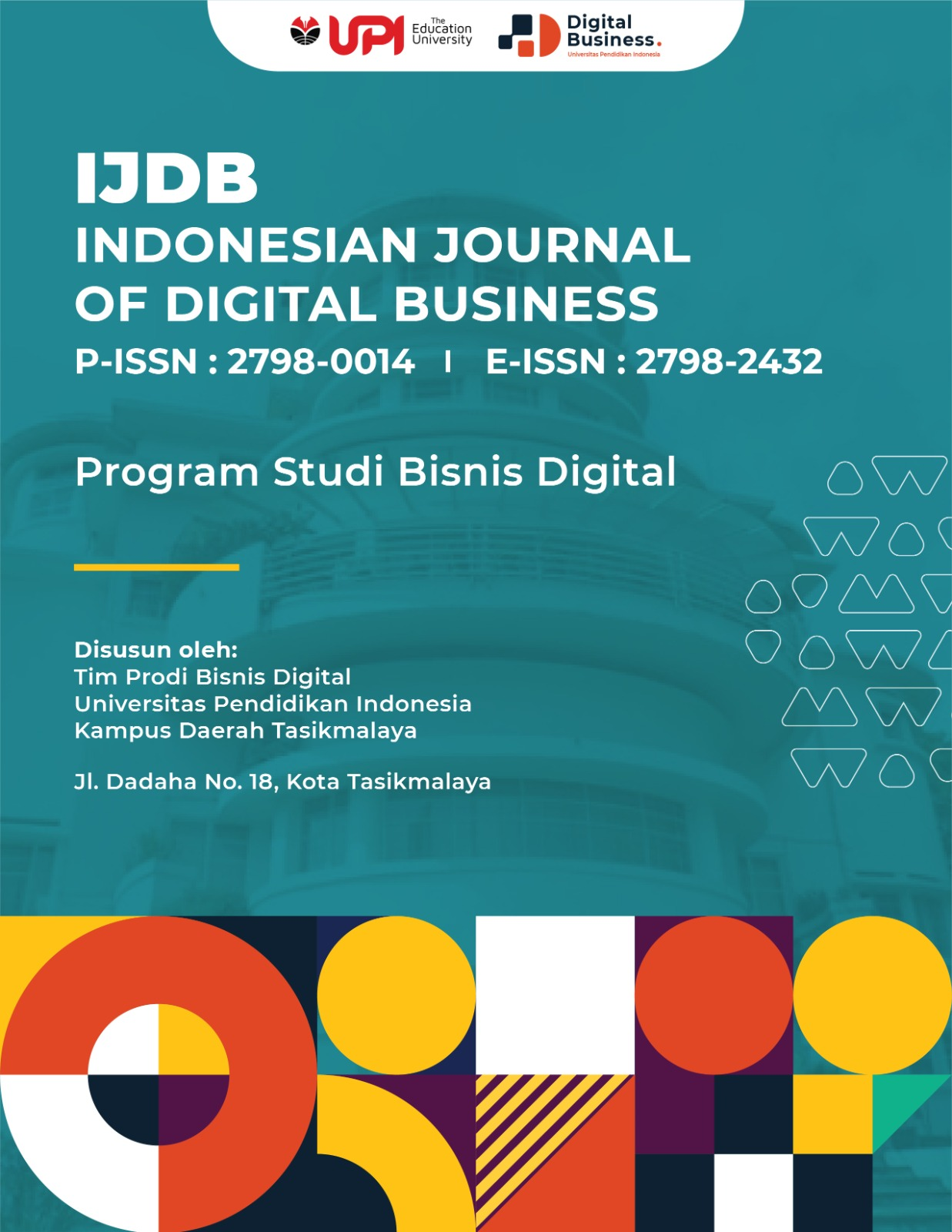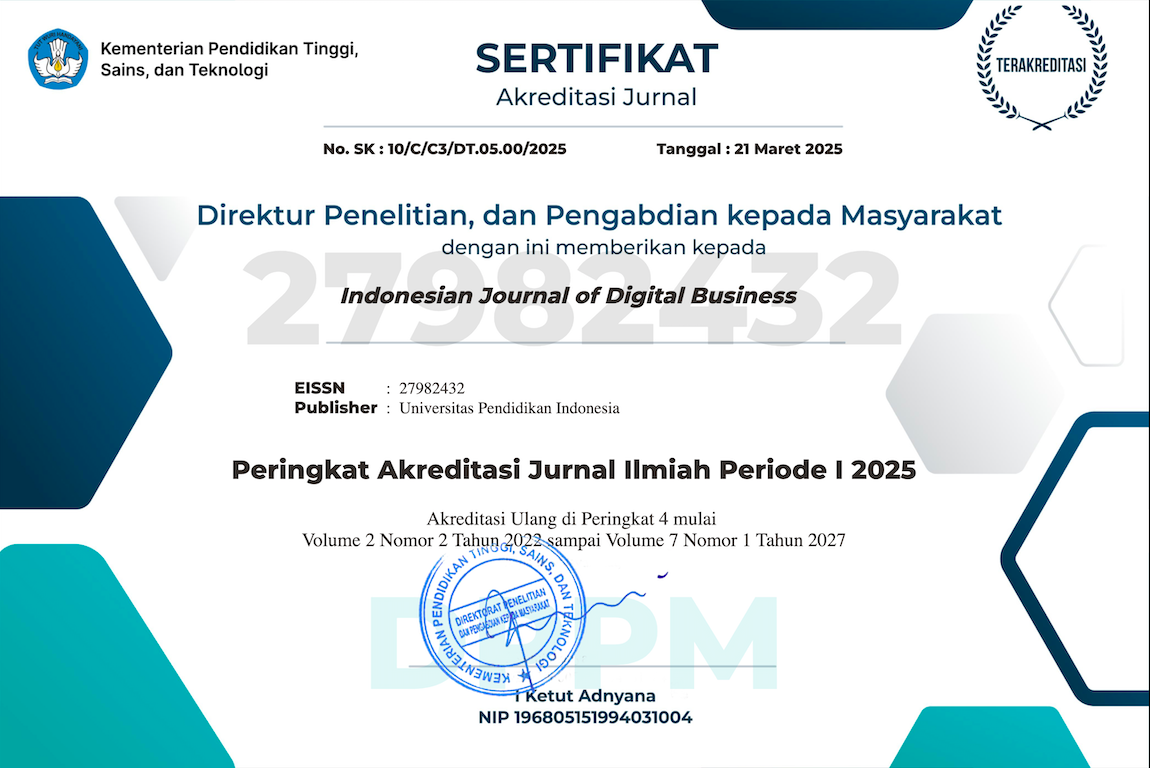Comparison of the Use of M-Banking Apps for BRImo with Regard to Generation Z and Generation Millennial
Abstract
The purpose of this research is to analyze the differences in how Generation Z and Generation Millennial perceive BRImo in terms of perceived ease of use and perceived usefulness. Perceived ease of use consists of six indicators: easy to understand, controllable, understandable, flexible, skilled, and simple to use. Meanwhile, perceived usefulness includes speeding up work, improving performance, increasing productivity, effectiveness, making work easier, and utility. This research employs a quantitative approach using a purposive sampling technique, with 150 BRImo users as respondents. Data was collected through a g-form questionnaire, and the perceived ease of use and perceived usefulness variables were analyzed using the Mann-Whitney U test, a non-parametric statistical method. The results indicate significant differences between Generation Z and Millennials in using BRImo. Generation Z adapts more easily to digital services, while Millennials tend to be more cautious. Statistical analysis confirms these differences, with asymptotic significance values of 0.005 for perceived usefulness and 0.001 for perceived ease of use. This research provides valuable insights into how Generation Z and Millennials perceive m-banking, benefiting banks, fintech developers, and academics in enhancing user experience and optimizing digital financial services to meet generational preferences.
Keywords
Full Text:
PDFReferences
Abu Daqar, M. A. M., Arqawi, S., & Karsh, S. A. (2020). Fintech in the eyes of Millennials and Generation Z (the financial behavior and Fintech perception). Banks and Bank Systems, 15(3), 20–28. https://doi.org/10.21511/bbs.15(3).2020.03
Anam, H., Nurhayati, N., & Vanaldo Boang Manalu, R. (2020). Persepsi Kegunaan, Persepsi Kemudahan, Keamanan Dan Kerahasiaan, Kesiapan Teknologi Informasi Terhadap Intensitas Perilaku Dalam Penggunaan E-Filing. Jurnal GeoEkonomi, 11(1), 1–15. https://doi.org/10.36277/geoekonomi.v11i1.104
Andrea, B., Gabriella, H. C., & Tímea, J. (2016). Y and Z generations at workplaces. Journal of Competitiveness, 8(3), 90–106. https://doi.org/10.7441/joc.2016.03.06
Aritonang, R. S., Astiti, S., Fernandez, S., Informasi, P. S., Informatika, F., Tengah, J., & Testing, U. (1978). Analisis Perbandingan Nilai Usability Pada Mobile Banking Menggunakan Metode SUS dan NAU. 17(x), 277–286.
Bigné-Alcaiz, E., Ruiz-Mafé, C., Aldás-Manzano, J., & Sanz-Blas, S. (2008). Influence of online shopping information dependency and innovativeness on internet shopping adoption. Online Information Review, 32(5), 648–667. https://doi.org/10.1108/14684520810914025
Davis, F. D. (1989). Perceived usefulness, perceived ease of use, and user acceptance of information technology. MIS Quarterly: Management Information Systems, 13(3), 319–339. https://doi.org/10.2307/249008
Farida, A. L. (2022). Pengujian kinerja keuangan: Sustainable development goals sebagai intervening di Bursa Efek Indonesia. Fair Value: Jurnal Ilmiah Akuntansi Dan Keuangan, 4(10), 4790–4796. https://doi.org/10.32670/fairvalue.v4i10.1650
Fitri, M. A., & Nasution, M. I. P. (2023). Manfaat Dan Pengaruh Penggunaan Mobile Banking Dalam Meningkatkan Kualitas Pelayanan Pada Nasabah Bri. Kohesi: Jurnal Sains Dan …, 01(11), 31–40. https://ejournal.warunayama.org/index.php/kohesi/article/view/1156
Fitriati, A., Tubastuvi, N., Mudjiyanti, R., & Wahyuni, S. (2024). Mobile banking acceptance model for Generation Z : The role of trust , self-efficacy , and enjoyment. 25(3). https://doi.org/10.18196/jai.v25i3.21639
Harahap, B. A., Idham, P. B., Kusuma, A. C. M., & Rakhman, R. N. (2017). Perkembangan Financial Technology Terkait Central Bank Digital Currency (CBDC) Terhadap Transmisi Kebijakan Moneter Dan Makroekonomi. Bank Indonesia, 2, 1–80.
Jampur, E. a. (2023). Media Sosialisasi Abdimas Widya Karya Lembaga Penelitian dan Pengabdian kepada Masyarakat. Jurnal Asawika, 8(1), 37–41.
Marginingsih, R. (2020). Kualitas Mobile Banking Terhadap Kepuasan Nasabah Bank BRI (Studi Pada Pengguna BRI Mobile di Kota Depok). Moneter - Jurnal Akuntansi Dan Keuangan, 7(1), 24–31. https://doi.org/10.31294/moneter.v7i1.7475
Mu’asiroh, L. R., & Darwanto, D. (2021). Analisis Penggunaan Mobile Banking pada Generasi Milenial dengan Pendekatan Technology Acceptance Model (TAM). Ad-Deenar: Jurnal Ekonomi Dan Bisnis Islam, 5(02), 155. https://doi.org/10.30868/ad.v5i02.1241
Noer, A. (2024). Perlindungan Hukum Bagi Para Pihak Terhadap Terjadinya Sistem Error Pada Penyelenggaraan M-Banking. 2(3), 93–105. https://doi.org/10.59059/mandub.v2i3.1356
Novalin, L. (2023). PENGARUH KUALITAS LAYANAN MOBILE BANKING TERHADAP KEPUASAN DAN DAMPAKNYA PADA LOYALITAS NASABAH PENGGUNA BRImo DI KOTA MEDAN. September 1998, 14.
Noviarni Eni. (2014). Analisis Adopsi Layanan Internet Banking Oleh Nasabah. Perbankan Di Pekanbaru (Technology Acceptance Model). Jurnal Al-Iqtishad, 10, 27–40. https://ejournal.uin-suska.ac.id/index.php/al-iqtishad/article/view/3111/1988
Nurahmasari, M., Nur Silfiyah, S., & Haposan Pangaribuan, C. (2023). The Intention to Use Digital Banking Services among Gen Z in Indonesia Based on Technology Acceptance Model (TAM). Jurnal Manajemen Dan Bisnis Madani, 5(1), 15–31. https://doi.org/10.51353/jmbm.v5i1.692
Pandey, R. (2015). Commonly used t-tests in medical research. Journal of the Practice of Cardiovascular Sciences, 1(2), 185. https://doi.org/10.4103/2395-5414.166321
Pratiwi, D. N., Dewi, F. P., & Ayuningtyas, V. (2022). Financial Technology (FINTECH): Generasi Z dan Generasi Milenial. Seminar Inovasi Manajemen Bisnisdan Akuntansi(SIMBA) 4, 4(September), 1–8. http://prosiding.unipma.ac.id/index.php/SIMBA/article/view/3593
Purwanto, E., & Loisa, J. (2020). The Intention and Use Behaviour of the Mobile Banking System in indonesia: UTAUT Model. Technology Reports of Kansai University, 62(06), 2757–2767. https://www.researchgate.net/publication/343230847
Saputra, M. S., & Nurjihadi, M. (2023). Sikap Mahasiswa dalam Adopsi Aplikasi Keuangan BRIMO dengan Pendekatan Technology Acceptance Model (TAM). BIOS : Jurnal Teknologi Informasi Dan Rekayasa Komputer, 4(1), 18–24. https://doi.org/10.37148/bios.v4i1.59
Sriwidadi, T. (2011). Penggunaan Uji Mann-Whitney pada Analisis Pengaruh Pelatihan Wiraniaga dalam Penjualan Produk Baru. Binus Business Review, 2(2), 751. https://doi.org/10.21512/bbr.v2i2.1221
Venkatesh, V., & Davis, F. (2000). A theoretical extension of the tecgnology acceptance model: Four longitudinal field studies University of Maryland at College Park. Management Science, 46(2), 186–204.
Wijaya, J. P., & Setiawan, A. S. (2022). Aplikasi Technology Acceptance Model (Tam) Terhadap Penggunaan Internet Banking & Mobile Banking. Prosiding National Seminar on …, 1, 322–333. https://journal.ukmc.ac.id/index.php/pnsoa/article/view/608%0Ahttps://journal.ukmc.ac.id/index.php/pnsoa/article/download/608/597
Yoon, G. S., Kim, Y. H., & Lim, S. J. (2012). Division Technique Training Tool for Problem Solving Methods of IPR. Creative Education, 03(08), 130–135. https://doi.org/10.4236/ce.2012.38b027
DOI: https://doi.org/10.17509/ijdb.v5i1.83445
Refbacks
- There are currently no refbacks.
Copyright (c) 2025 Universitas Pendidikan Indonesia (UPI)

This work is licensed under a Creative Commons Attribution-ShareAlike 4.0 International License.
Indonesian Journal of Digital Business is published by Universitas Pendidikan Indonesia (UPI)
and managed by Department of Digital Business
Jl. Dr. Setiabudi No.229, Kota Bandung, Indonesia - 40154
View My Stats





1.png)